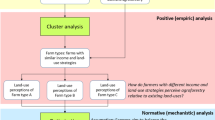Abstract
Planning agroforestry research programs requires the participation of people from many disciplines. They may have different interests in allocating financial resources for research purposes and, therefore, the decision-making is complex. Guidelines are needed to improve the decision-making process. Such guidelines may include a list of weighted criteria identified by experts through group processes. This study used a qualitative approach (the Delphi method) to identify criteria to be used when planning agroforestry research programs in the developing countries. The panel of respondents was comprised of agroforestry experts who have experience and expertise in the developing countries. Fourteen (14) criteria were identified in questionnaire 1. These criteria were ranked in questionnaires 2 and 3. A Friedman test of analysis of variance followed by a Mann-Whitney U test of pairwise comparison produced four groups of criteria: group 1, the most highly ranked, comprises local people's needs, sustainability, adoptability and research quality; group 2 includes existing systems and economic criteria; group 3 encompasses biophysical effects, institutional capabilities, partnership and transferability; and group 4, the least ranked, includes diversity of products, tree/crop interface, flexibility and species selection. A Kruskal-Wallis test on each criterion and several respondent characteristics showed that the respondent characteristics of current work, highest degree held, ecosystem experience, geographic area of experience, and number of years experience influenced respondent criteria rankings. The test was not significant for background and respondent origin characteristics.
Similar content being viewed by others
References
Bramante C Antonio (1988) Establishing a basis for the development of an undergraduate curriculum in recreation and leisure studies in Brazil: a Delphi approach. Unpublished Ph.D. Dissertation. Pennsylvania State University, 231 pp
Brockhaus, WL and Mickelsen, JF (1977) An analysis of prior Delphi applications and some observations on its future applicability. Technological Forecasting and Social Change 10: 103–110
Brooks, KW (1979) Delphi technique: expanding applications, North Central Association Quarterly 53: 337–385
Crance, JH (1987) Guidelines for using the Delphi technique to develop habitat suitability index curves. US Fish and Wildlife Service. Fort Collins, Colorado, 10 pp
Delbecq, L, Van de Ven, AH and Gustafson, DH (1975) Group techniques for program planning: a guide to Nominal Group and Delphi Process. Scott, Foresman and Company. Glenview, Illinois, 174 pp
Fusfeld, AR and Foster, RN (1971) The Delphi technique: survey and comment. Business Horizons 14: 63–74
Helmer, O (1983) Looking Forward: A Guide to Future Research. Sage Publications. Beverly Hills, CA, 45 pp
Hodgetts, RM (1977) Applying the Delphi technique to management gaming. Simulation 29(1): 209–212
Linstone, AH and Turoff, M (1975) The Delphi Method. Technique and Application. Addison-Wesley Publishing Company, Inc. Reading, Massachusetts, USA, 620 pp
Ludlow JD (1972) Evaluation of methodology of the University of Michigan's Sea Grant Delphi inquiry. University of Michigan Sea Grant Tech. Rep. 23. Ann Arbor, 90 pp
MacDicken, KG and Vergara, NT (1990) Agroforestry Classification and Management. John Wiley and Sons Inc. New York, 382 pp
Moderator MD (1980) Status and progress of multiple-use research. USDA For Serv Gen Tech Rep WO 25, Washington DC
Raintree, JB and Lundgren, B (1985) Agroforestry potentials for biomass production in integrated land-use systems. Symposium on biomass energy system: building blocks for sustainable agriculture. World Resource Institute, Washington, D.C., USA
Rieger, WG (1986) Directions in Delphi development: dissertation and their quality. Technological Forecasting and Social Change 29: 195–204
Rocheleau, D, Weber, F and Field-Juma, A (1988) Agroforestry in dryland Africa. International Council for Research in Agroforestry, Nairobi, Kenya, 311 pp
Rule, C and O'Laughlin, J (1989) Expert opinion on the future production of five manufactured wood products in the Pacific Northwest. Unpublished Ph.D Dissertation, Department of Forest Science, Texas A&M University, College Station, TX, 313 pp
Schuster EG (1985) The Delphi method: application to elk habitat quality. USDA, For Service Research Pap. INT-353, 32 pp
Schuster, EG and Frissel, SS (1990) Delphi: an information tool for resource management, pp 41–42. In: Proceedings of the third symposium on social science in resource management, May, 16–19, 1990. Texas A&M University, College Station, Texas
Singg, RN and Webb, BR (1979) The use of the Delphi methodology to assess goals and social impact of a watershed project. Water Resource Bulletin 15: 136–143
Turoff, M (1970) The design of a policy Delphi. Technological Forecasting and Social Change 2: 149–171
Vanden Berg GE (1980) Systematic procedure for planning research. US Department of Agriculture, Science and Education Administration. Agricultural Reviews and Manuals ARM-NE-8, 44 pp
Author information
Authors and Affiliations
Rights and permissions
About this article
Cite this article
Ndour, B., Force, J.E. & McLaughlin, W.J. Using the Delphi method for determining criteria in agroforestry research planning in developing countries. Agroforest Syst 19, 119–129 (1992). https://doi.org/10.1007/BF00138502
Issue Date:
DOI: https://doi.org/10.1007/BF00138502




